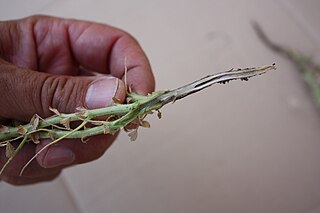
Zymoseptoria tritici, synonyms Septoria tritici, Mycosphaerella graminicola, is a species of filamentous fungus, an ascomycete in the family Mycosphaerellaceae. It is a wheat plant pathogen causing septoria leaf blotch that is difficult to control due to resistance to multiple fungicides. The pathogen today causes one of the most important diseases of wheat.

Phaeosphaeria nodorum is a major fungal pathogen of wheat, causing the disease Septoria nodorum blotch. It is a member of the Dothideomycetes, a large fungal taxon that includes many important plant pathogens affecting all major crop plant families.

Didymella pinodes is a hemibiotrophic fungal plant pathogen and the causal agent of ascochyta blight on pea plants. It is infective on several species such as Lathyrus sativus, Lupinus albus, Medicago spp., Trifolium spp., Vicia sativa, and Vicia articulata, and is thus defined as broadrange pathogen.
Septoria aciculosa is a fungal plant pathogen infecting strawberries. This pathogen primarily affects coniferous trees, particularly those in the pine family (Pinaceae). This fungus is known to cause a specific disease called "needle cast" or "Septoria needle cast."
Septoria ampelina is a fungal plant pathogen that affects grapes causing septoria leaf spot.
Septoria azaleae is a fungal plant pathogen infecting azaleas.
Septoria citri is a fungal plant pathogen infecting citruses.
Septoria cucurbitacearum is a fungal plant pathogen infecting cucurbits. Symptoms of Septoria leaf spot are similar on all the cucurbits infected.
Septoria fragariae is a fungal plant pathogen affecting strawberries.
Septoria helianthi, also known as Septoria leaf spot, is a fungal plant pathogen infecting sunflowers.
Septoria menthae is a fungal plant pathogen infecting mint. It is the causal organism of mint leafspot.
Septoria pistaciae is a fungal plant pathogen infecting pistachios. It causes a disease known as septoria leaf spot in the leaves of pistachio, along with the related species septoria pistaciarum and septoria pistacina.
Fusarium oxysporum f.sp. pisi is a fungal plant pathogen infecting peas, endemic to Moldova.

Fusarium solani f.sp. pisi is a fungal plant pathogen infecting peas.

Ascochyta pisi is a fungal plant pathogen that causes ascochyta blight on pea, causing lesions of stems, leaves, and pods. These same symptoms can also be caused by Ascochyta pinodes, and the two fungi are not easily distinguishable.
Septoria lycopersici is a fungal pathogen that is most commonly found infecting tomatoes. It causes one of the most destructive diseases of tomatoes and attacks tomatoes during any stage of development.
Septoria fragariaecola is a fungal plant pathogen infecting strawberries.

Septoria malagutii is a fungal plant pathogen infecting potatoes. The casual fungal pathogen is a deuteromycete and therefore has no true sexual stage. As a result, Septoria produces pycnidia, an asexual flask shaped fruiting body, on the leaves of potato and other tuber-bearing spp. causing small black to brown necrotic lesions ranging in size from 1-5mm. The necrotic lesions can fuse together forming large necrotic areas susceptible to leaf drop, early senescence, dieback, and dwarfing. Septoria malagutii has been found only in the Andean countries of Bolivia, Ecuador, Peru, and Venezuela at altitudes of near 3000 meters. Consequently, the fungi grows and disperses best under relatively low temperatures with high humidities, with optimal growth occurring at 20 °C (68 °F). The disease has caused devastation on potato yields in South America and in areas where this disease is common, potato yields have been seen to drop by 60%.

Uromyces pisi-sativi is a fungal species and plant pathogen. It was originally found on Pea but it is found on a wide range of host plants.

Ascochyta blights occur throughout the world and can be of significant economic importance. Three fungi contribute to the ascochyta blight disease complex of pea. Ascochyta pinodes causes Mycosphaerella blight. Ascochyta pinodella causes Ascochyta foot rot, and Ascochyta pisi causes Ascochyta blight and pod spot. Of the three fungi, Ascochyta pinodes is of the most importance. These diseases are conducive under wet and humid conditions and can cause a yield loss of up to fifty percent if left uncontrolled. The best method to control ascochyta blights of pea is to reduce the amount of primary inoculum through sanitation, crop-rotation, and altering the sowing date. Other methods—chemical control, biological control, and development of resistant varieties—may also be used to effectively control ascochyta diseases.






